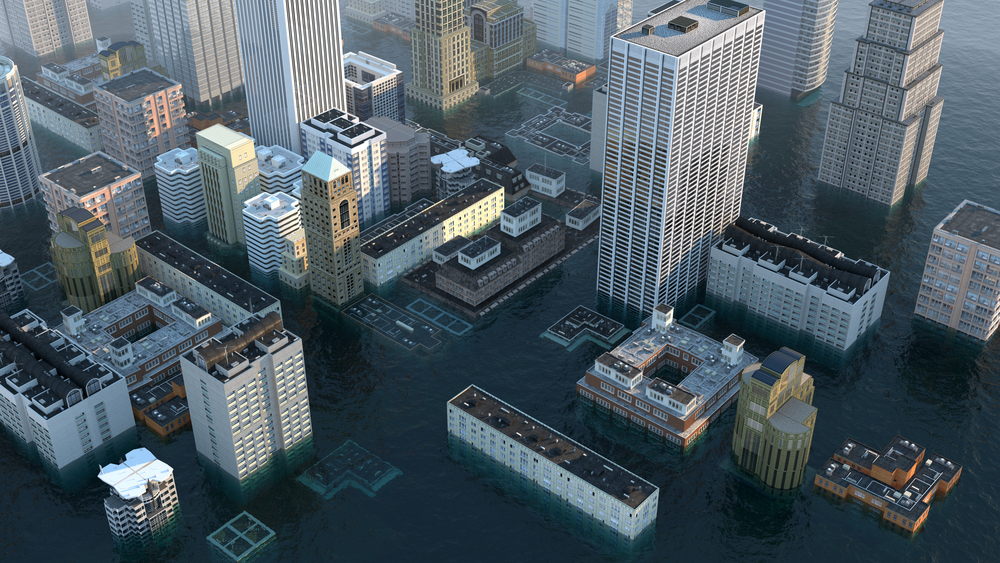
Grey Infrastructure, Coastal Cities, and Climate Change: How Communities Can Prepare for Increased Flooding
Cities are about to get much wetter as global warming increases the intensity of storms, raises sea levels, and disrupts established climate expectations. Moreover, grey infrastructures in cities are straining to keep up with the growth of urban populations. The pattern of increased storms and frequent flooding requires cities to be proactive in finding a solution for water management and emergency systems or risk being overwhelmed by flooding and constant clean-up.
Grey infrastructure is a collection of pipes, pumps, ditches, and retention ponds engineered by people to manage water in populated areas. These systems require continual maintenance and often need to be upgraded. An increase in urbanization, as well as higher volumes of runoff and stormwater due to changing weather patterns, are putting unprecedented stress on these systems throughout the country and across the globe.
The United Nations in 2009 and the International Organization for Migration in 2015 both estimated that 3 million people move into cities every week. Now more than half of the world — 54 percent — are living in cities, which is up by 30 percent since 1950. In order to deal with this increase in population, cities are forced to update decades-old infrastructure while new weather patterns complicate the process even more.
According to ScienceNews.org, cities across the United States can expect to see more flooding as a result of these changing weather patterns and increasing populations. New York is projected to receive 13 days of coastal flooding before April 2020, while Boston is projected to receive 12 to 19 days.
The biggest issue with outdated grey infrastructure is running out of room for stormwater and runoff. Maxed-out reservoirs result in sunny-day flooding. This type of flooding occurs on days following rain showers where streets and sidewalks will be overflowing with water because the system is not prepared to handle the increased rainfall.
Many coastal cities even see street flooding at high tide due to sea-level rise. High tide waters overwhelm the pipes designed to expel water from cities and end up spilling out onto the streets when the seawater is the highest. While there are short-term solutions such as one-way drainage pipes, these issues require long-term solutions.
The city of Charleston is being proactive by creating a stormwater department to address ongoing issues. The city requested $32 million from the state to raise its seawall by half a foot to accommodate the recorded 1.07-foot rise of the Charleston harbor since 1921.
Steps to Reduce and Respond to Flooding
While many of the solutions are dependent on the local, state, and even national governments, there are still steps that individuals and communities can take to reduce stormwater and sunny-day flooding.
Elevate Your Home
Homeowners in areas that flood frequently can raise their homes, although it is an expensive solution. Many cities are requiring that new homes and buildings be constructed at a higher sea level than previously required. If you are preparing to move, be sure to check the flood history of a new property as well as the surrounding area. If the area is prone to flooding, see if necessary updates have been made to the property.
Prepare for Possible Flooding
Sandbags at doorways can help to keep water from coming in and ruining floors and other valuables, especially when sunny-day flooding is frequent in your area, and you may not be home to help mitigate the damage. Also, consider raising electric outlets and elevating all appliances and valuables to a safe height in case of flooding.
Landscape with Water-Absorbing Plants
Water-absorbing species of plants may not be an effective solution if you are facing hurricane-level flooding, but they can help to lower your nuisance flooding and remove excess water from your yard.
These species include:
- Willow
- Ash
- Red maple
- River Birch
- Dogwood
- Spicebush
- Blueberry
- Winterberry
- Jack-in-the-pulpit
- Sweet Woodruff
- Sweet Flag
- Iris
Protect Your Car
Car owners will want to ensure that they are parked in elevated areas, especially when a flood or storm is nearing. Leaving a pair of rain boots and an umbrella in your car is a good idea as well.
Create an Emergency Plan
Be sure to have an emergency kit assembled in worst-case scenarios. Include food, bottled water, first-aid supplies, medicines and a battery-operated radio in your emergency kit. Also have an exit strategy in case of severe flooding, such as emergency contacts, a communication plan with family members and friends, as well as a place to stay in case you need to evacuate.
You can visit FEMA’s Flood Map Service Center (https://msc.fema.gov/portal/search ) to find your community’s flood map and to see your area’s flood risk. Be sure to research your local community’s emergency services including locations, contact information, and warning systems.
At StrongGo, protecting our world and making it a safer place is our priority. We research and manufacture innovative and high-quality products that improve infrastructure to make the world more accessible. Talk to our experts at csd@stronggo.com.


